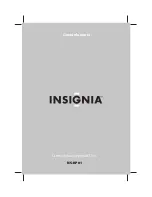
T251i T
rapezoidal Speaker System
T251i Trapezoidal Speaker System
2
It is the installer’s responsibility to ensure
the speaker system has been installed cor-
rectly. Electro-Voice strongly recom-
mends that all suspended items be in-
spected at least once a year and any dam-
aged parts be replaced immediately.
All Electro-Voice HS- and HST- systems
follow the same principles. Put minimum
stress on the cabinet and make each cabinet
hang independently of any other device.
Suspending the Electro-Voice T251i
Speaker System
Part of the T251i’s versatility is that it can
be mounted either vertically or horizontally,
and has a rotatable horn. The mounting sys-
tem is conceptually very simple. Two alu-
minum tubes pass vertically through the cabi-
net and each is secured via two oversize cast
brackets (threaded flanges). The enclosure
is sandwiched between the four (two on each
end) brackets. The enclosure is essentially
resting between the brackets.
When installing the T251i, two of the three
supplied forged eyebolts are screwed into the
upper two brackets. The third eyebolt should
be screwed into the appropriate T-nut on the
rear panel of the enclosure. When mount-
ing the enclosure vertically, use the lower
T-nut. When mounting the enclosure hori-
zontally, use the T-nut located in the center
of the rear panel of the enclosure. This is
necessary for aiming the system. The center
of gravity is arranged so the enclosure is di-
rected towards the ceiling. In order to pro-
vide a downward or horizontal projection
angle, the pull-up point must be used.
If multiple cabinets are to be suspended, each
system requires its own rigging points. Sys-
tems should not be suspended from each
other. The eyebolts must be connected us-
ing suitably rated chain with connectors such
as shackles or threaded chain connectors, or
suitably rated aircraft cables to suspend and
aim the system.
Constant-Directivity Speaker System
The crossover frequency and speaker com-
ponent geometries have been selected so that
the directional characteristics of the woofer
and constant-directivity horn match at the
crossover frequency (approximately 90° cir-
cular coverage patterns for each) to create a
special system type—the constant-directiv-
ity system. At higher frequencies the hori-
zontal coverage pattern remains constant and
the vertical pattern smoothly transitions to a
40° angle above 4,000 Hz. Response within
the 60° x 40° rated coverage angle is uni-
form, which means dependable audience
coverage without hot spots or dead zones at
certain frequencies. The 60° x 40° disper-
sion characteristic also helps avoid early re-
flections from nearby floor or side wall sur-
faces which could degrade intelligibility.
The controlled directivity of the high- and
low-frequency transducers also eliminates
response irregularities caused by diffraction
off nearby enclosure edges and, in combina-
tion with an essentially flat on-axis frequency
response, produces a total acoustic power
output that is uniform with frequency.
Enclosure Construction
A combination of dado-cut joints, tough ad-
hesives and proper bracing ensures a soni-
cally dead enclosure free from panel reso-
nances. The flying hardware is preinstalled
in the T251i. The exterior of the T251i is
covered with a white textured paint that is
also paintable if the installer desires.
Rotating the High-Frequency Horn
The T251i high-frequency horn may be eas-
ily rotated about its major axis, providing
coverage independent of enclosure orienta-
tion. First remove the enclosure grille, then
the horn. Both are affixed with #2 Phillips-
head screws. Rotate the horn 90° about its
axis and reinstall the components.
Connections
Biamped or passive crossover with Neutrik
Speakon
®
connectors. Pins 1+ and 1- are used
in passive crossover.
Biamped Operation
The T251i is shipped from the factory in “full
range mode” with its passive crossover uti-
lized. If biamp operation is desired, this is
easily achieved. The input panel/crossover
assembly (on the back of the system) must
first be removed using a #2 Phillips screw-
driver. After removing the input panel/cross-
over assembly, notice the crossover instruc-
tion label on the side of the panel. There are
four automotive fuses on the printed circuit
board. These fuses are not functioning as
fuses, but rather are functioning together as
a four pole switch. To convert the T251i to
biamp operation, move each fuse over one
position. The fuses should, once again, all
be in one column and nearest the word BI-
AMP on the printed circuit board. Replace
the input panel/crossover assembly in the
enclosure and carefully replace the screws–
being careful not to strip the holes. To return
the system to full-range operation, repeat the
steps in a similar manner. Remember, all
fuses must be arranged in a vertical col-
umn for safe, proper operation.
Neutrik Speakon
®
connectors are used. Pins
1+/1– are wired to the low-frequency driver
and pins 2+/2– to the high-frequency sec-
tion. The high-frequency section incorpo-
rates a low-frequency blocking capacitor
with a 3-dB-down point of 800 Hz and
PRO
TM
circuit auto resetting overload pro-
tection.
Frequency Response
The combination of a 15-inch woofer, wide-
bandwidth high-frequency driver and an
equalized crossover results in the wide and
smooth overall response shown in Figure 1.
The T251i’s axial frequency response was
measured in Electro-Voice’s large anechoic
chamber at a distance of 10 feet with a swept
sine-wave input of 4 volts. Figure 1 has been
averaged and corrected for 1 watt/1 meter.
Directivity
A unique feature of the T251i is the con-
stant-directivity dispersion provided by the
60° x 40° horn. The polar response of the
system at selected one-third-octave band-
widths is shown in Figure 2. These polar re-
sponses were measured in an anechoic envi-
ronment at 10 feet using one-third-octave
pink-noise inputs. The frequencies selected
are fully representative of the polar response
of the system. Beamwidth of the system uti-
lizing the complete one-third-octave polar
data is shown in Figure 3. R
θ
and directivity
index (D
i
) are plotted in Figure 4.
























